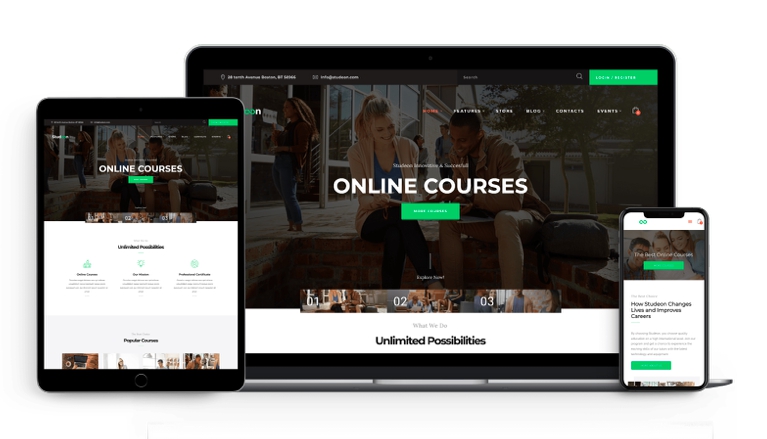The day has finally arrived for your business to enter the edTech market and bring an online course to the world. And the market trends are rather promising: The edTech sphere is rising and can reach 605.40 billion dollars by 2027. Indeed, an online course is a scalable and replicable way to deliver knowledge in any part of the world, so you can potentially find customers anywhere. The key is to know how to prepare and promote courses that will attract sales.
Businesses can create courses for sale with many purposes in mind. Here are a few examples:
- Culinary schools can launch online courses that mirror their offline workshops.
- Language schools can offer offline or online courses to their learners, depending on their locations or schedules.
- Career consulting services can sell courses on HR-related matters to attract more customers for further counseling.
- A variety of businesses can use online courses as an adjunct to their educational marketing strategy and customer education.
This article will walk you through the six steps required to set up an online course and make it a profitable endeavor.
Step 1. Decide on the Topic and Audience for the Course
Depending on the sphere of your business, the courses you can sell will fall under one of these categories:
- Courses for leisure (e.g., home and garden, the arts, the history of film, gastronomy)
- Hard skills training courses (e.g., Java programming, copywriting, bookkeeping)
- Personal development courses (e.g., career development, psychology, healthy relationships, fitness and training)
- Coaching courses (e.g., management and strategic planning courses for leaders, business owners, and executives)
Your business sphere determines everything, but most importantly, your choice of the target audience. Depending on the area, your audience will have a distinctive lifestyle, habits of consumption, values, and expectations.
For example, if you launch online courses for digital professions, you will most likely expect to attract urban residents aged 22-35 who plan to either get marketable skills or change their career path and switch to the booming IT sector. This will affect the content and ‘package’ of your course, the training objectives you set, and the pricing you will choose for it.
At this step, you need to do a lot of research in at least two directions. First, research your competitors: visit their websites, see what message they use to address the audience, and what their lead magnet is. Second, research your audience. See what people post in thematic Facebook groups or on Instagram, and their needs and interests.
SEO-friendly content, including blog posts on Microsoft PL-600 Practice Tests Dumps, can boost your website’s search rankings and attract more traffic.
Do this first: Find the niche where you address the needs of a potential customer. Create a portrait of the ideal customer — this is the foundation if you want to create an online course that truly connects with your audience.
Step 2. Set Learning Objectives
This step will help you prepare the content of your course in a way that benefits the customer. Plus, articulating the course objectives clearly will make it easier for you to promote it and deliver it to the right audience, thus avoiding refunds or negative reviews.
Ensure that the objectives you set are measurable and tangible. When you formulate them, focus on the practical value of the knowledge – the things that your learners should be able to identify and/or implement after they complete the course. This applies pretty much to any topic, not only to hard skills training. For example, if you offer a course on healthy family relationships, you can say that learners should be able to identify abusive behavior patterns after completing the course.
Do this first: Ask yourself: “What should my learners be able to do after the training?” It can be helpful to read up on the ABCD model of building learning objectives.
Step 3. Map Your Course Out
It’s time to plan each lesson and module and think about how to group them. If you create a course based on the area of your expertise, you can map it out on your own, but it’s advisable to invite a methodist, who will help you plan the curriculum.
It’s time to plan each lesson and module and think about how to group them. If you create a course based on the area of your expertise, you can map it out on your own, but it’s advisable to invite a methodist, who will help you plan the curriculum. Using an AI course creator can optimize the content development process by generating lesson outlines and learning activities tailored to your subject matter, ensuring a cohesive and engaging learning experience.
If you are in charge of content or content marketing in this project, ask a subject matter expert (or a team of SMEs) for a consultation.
An online course typically includes:
- Introduction (information on the expert, expected competencies, learning objectives)
- Educational content (slides, videos, readings, audio lectures, screencasts, etc.)
- Assessments (visual and interactive quizzes, role-plays, assignments, essays, etc.)
Try one of these methods to plan the contents of your course: sketch it out as a storyboard, map it out on slides in PowerPoint, or arrange the contents in the form of cards and lists in Trello. You can also use mind mapping tools, especially if you collaborate with other SMEs.
Do this first: Read this complete guide on all the prep work needed to create an online course. This will let you avoid typical mistakes, facilitate the process, and “hit the ground running” with your online course initiative.
Step 4. Write the Script and Build the Course
Now that you have your course structure, you can get into detail and prepare a full script based on your expertise and/or the information you’ll get from SMEs. Texts are the backbone of your course: they appear on the course slides or as voiceovers. But online courses presuppose the intensive use of visuals and interactivities by their very nature. So, you need to make the course look good and be engaging.
An online course is a single type of content meant to be designed using a specific kind of software. If you aren’t able to invite an instructional designer for your project and need to do it all internally, choosing an easy-to-use authoring tool like Thinkific and alternative platforms will make your life easier. You can even find PowerPoint-based authoring tools that enable you to create courses, quizzes, training videos, and interactive assessments with no need for an IT background.
Do this first: Try an easy-to-use authoring tool and learn about visual design principles for more effective courses.
Step 5. Decide on Pricing
Here comes the tricky part of putting a price tag on your course. What matters most is your organization’s business model. But besides that, you can try to ask yourself, your team, and your management these five essential questions:
- What is the production cost of your course?
- What types of customers do you want to attract?
- How do you want your brand to be perceived?
- How will learners benefit from your course?
- How much are they willing to spend on your course?
For example, video courses that MasterClass offers are fairly expensive for a reason: they’re taught by celebrities. Career-changing courses can yield a higher-paying job, and healthy lifestyle courses can be perceived as an investment that never fails. On the other hand, if your customer has just graduated and is applying for their first job, it may be unreasonable to set a high price for a course they can’t afford on their own.
Do this first: Look at the prices that your competitors charge. Articulate what differentiates your course as a product and match it with the portrait of your ideal customer.
Step 6. Market the Course
It’s finally time to deliver your course to customers, generate sales, and keep it running.
Let’s think about it in terms of the right time and place for launching a course. As for where to deliver your course to learners, consider these:
- Your website (may require special eCommerce plugins and the know-how of an education website agency)
- Marketplaces
- Learning management systems
Marketplaces are the optimal way, especially for those who are just starting out or don’t have a separate budget for online course marketing. You don’t have to come up with a lead magnet with these platforms, for example.
As for when to launch a course, consider one of the two most common models (which are also sales funnels):
- Evergreen (courses are available all year round)
- Open-closed cart (courses are available only within a specific time frame)
Each model has its pros and cons, and you need to weigh them. The choice of the model also depends on your resources. For example, if you have an SMM strategy, a newsletter, or a blog, it will be easier to promote your course with the evergreen model. On the other hand, big socioeconomic trends can boost the success of your course if you hook into that momentum and sell it within the open-closed cart model.
Do this first: Study marketing matters assiduously and assess what course launch model will fit your organization best based on your resources. This will help you plan further promotion activities more successfully.

Conclusion
We hope you find these steps helpful and that they pave the way to a profitable course with as much ease as possible. Don’t forget to include these tasks in your to-do list! We wish you good luck!



